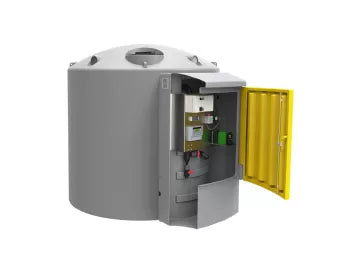Chemical storage has changed a lot in recent years. Self-bunded tanks are now the standard in the industry. Why do self-bunded tanks outperform single-walled tanks?
Concrete bunds are designed to stop spills from getting into the environment. They also add cost and take up space on a project. But they are essential because they keep things safe. Unfortunately, over time concrete bunds can deteriorate. If a spill happens when the bund is not in good condition, it will not work as it should.
Self-bunded tanks are made of high-quality materials that will not deteriorate over time. The tank itself is sealed off from the environment, so there is no need for a concrete bund. This saves money on construction costs, takes up less space on-site, and requires much less maintenance.
Self-bunded tanks are the clear choice for chemical storage today. They are safe, durable, and affordable – making them the best option for any project.
6 Reasons to Use a Self-Bunded Tank for Chemical Storage
Chemical storage tanks can be an essential piece of safety equipment on a worksite. However, they can also be expensive and time-consuming to build correctly. A better option for chemical storage is the self-bunded tank.- It is designed to store chemicals safely and securely. It comprises two parts: the tank itself and the bund. The bund is a concrete or brick enclosure that surrounds the tank and helps to keep the chemicals inside.
- A better option than traditional tanks and bunds for several reasons:
- Cheaper to build than a traditional single-walled tank with a concrete bund.
- Depending on the site's needs, it can be built to any size.
- They are made from sturdy materials that can withstand wear and tear.
- Easy to maintain and clean.
Overall, self-bunded tanks are a safer, more cost-effective option for chemical storage. If you plan to build a new storage tank on your worksite, consider using a self-bund tank instead.
Advantages of using a self-bunded tank for chemical storage
A self-bunded tank is an excellent option for storing chemicals on-site. This tank has a 110% bund capacity, meaning it can hold more than the amount of chemicals needed. In addition, this tank is UV-protected, so water ingress will not be a problem.
This tank is perfect for short or long-term storage. It is easy to move around the site. Another good thing about this tank is that it does not have some of the traditional tanks' problems. For example, repairing a traditional tank can cost between $15,000 and $30,000. The Polymaster self-bunded tank does not have these problems because it is self-contained.
Cost Effective
Self-bunded tanks are one of the most cost-effective ways to store fuel. The bunded structure ensures that any leaks or spills are contained, and the double-walled design helps to prevent contamination.
Self-bunded tanks can be easily transported and relocated, making them perfect for construction sites or other temporary storage applications.
Durability
A self-bunded tank is a type of fuel storage tank that is designed to be durable and long-lasting. Self-bunded tanks are made from two tanks that are placed side by side.
- The first tank is the inner tank, made from a high-quality, corrosion-resistant material.
- The second tank is the outer tank, which is a protective barrier. This barrier helps to prevent the inner tank from being damaged by external factors such as UV rays, chemicals, and physical impacts.
Self-bunded tanks are often used in industrial and commercial applications where durability and long service life are essential.
Versatility
Self-bunded tanks are a great way to store liquids, like oil and chemicals. They're also perfect for places where space is limited, like offshore oil rigs or in tight industrial areas.Self-bunded tanks can be used to store different types of products. They come in different sizes and can be moved to other locations if needed. They are also easy to transport, making them a versatile storage option.
How are self-bunded tanks cheaper to build than traditional ones with concrete bunds?
Self-bunded tanks are cheaper to build than traditional tanks with a concrete bund for a few reasons. First, the self-bunded tank does not require a large concrete structure to hold the fuel. This can save on both materials and construction time. Additionally, because there is no need to build a separate bund around the tank, it is cheaper to install a self-bunded tank than a traditional tank.
Why Self-bunded tanks are also easier to clean and maintain than traditional tanks.
This is because there is no need to enter the tank to clean it, and the self-contained nature of the tank means that there are fewer areas that can accumulate dirt and debris. As a result, self-bunded tanks require less time and effort to keep clean, which can save on maintenance costs. In conclusion, self-bunded tanks are cheaper to build than traditional tanks with concrete bunds. This makes them an attractive option for many businesses and homeowners looking to save money on their fuel storage needs.
Conclusion
Self-bunded tanks are a great way to store liquids like oil and chemicals. They're perfect for places where space is limited, like on offshore oil rigs or in tight industrial areas. Self-bunded tanks can be used to store different types of products in different sizes. They can be moved to different locations if needed, and they're easy to transport which makes them a versatile option for storage.

